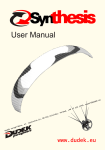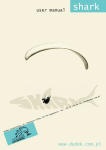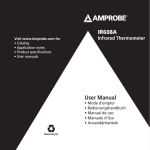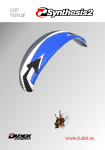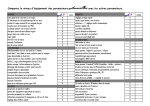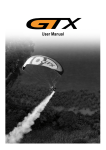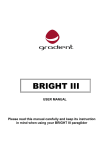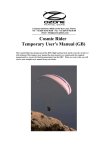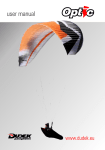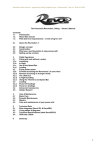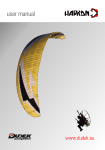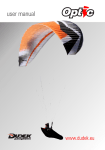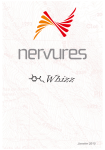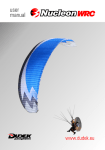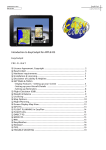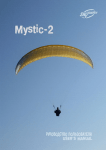Download manualACTIONwersja DUDEK.cdr
Transcript
User Manual User Manual v1.03 Page 1. Contents 1.1 What your wing comes with........................................................3 1.2 Introduction to this Manual...........................................................4 2. About the Action Wing: concepts of 2.1 Design.........................................................................................5 2.2 Construction................................................................................6 3. Flight Operations 3.1 Flying with and without a motor..............................................7 3.1.a Advanced manoeuvres......................................................9 3.2 Flying Under Power................................................................10 3.2.a Setting up the controls.......................................................10 3.2.b Forward Launching the Action in Nil Wind... .. .. .. .. .. .. .. .. .. .. 11 3.2.c Reverse Launching in Stronger Winds.............................13 3.2.d The Climb Out...................................................................14 3.2.e Level Right.........................................................................16 3.2.f Using the Trimmers and Speed Bar....................................16 3.3 Landing 3.3.a Power-off Landings............................................................17 3.3.b Power-on Landings............................................................17 3.4 Towing......................................................................................18 3.5 Golden Rules!!!.........................................................................19 4. Care & Maintenance 4.1 Basic Care..................................................................................20 4.2 Periodic Maintenance.................................................................21 4.3 Repairs.......................................................................................21 4.4 Care And Maintenance Of Your Power Unit................................22 5. Technical Data 5.1 Technical Specifications............................................................22 5.2 Riser Diagrams...........................................................................22 5.3 Lining Tables...............................................................................22 5.4 Lining Scheme............................................................................32 5.5 CEN Data Labels........................................................................32 6. Summary..................................................................................................34 USER MANUAL 1. Contents 1.1 WHAT YOUR ACTION COMES WITH $ The wing its self. $ Action multi-bag - This unique bag design doubles as both a smart, tough Cordura® travel ruck-sack… Or reverses to become a large protective fast field bag, to help protect your wing from UV exposure or rain, or for those times that you are feeling lazy and can't be bothered to fold your precious wing properly. $ An internal rip-stop carry bag - This lightweight internal bag provides an extra layer of protection and is ideal for carrying with you for landing out. $ A compression strap - For holding the wing together after folding. $ A wallet - With documentation and basic repair kit (with spare lines and universal repair tape). $ Two stage speed bar kit. $ This manual 3 1.2 INTRODUCTION The purpose of this manual is to offer guidelines to the experienced pilot in the use of the Action wing and it is in no way intended to be used as a training manual for this or any other paramotor or paraglider. You may only fly an aircraft of any description when qualified to do so or when undergoing training from an accredited School or Instructor. It must be understood that flying can be a dangerous activity unless undertaken by properly trained people flying in a responsible and disciplined manner. As the owner of an Action Paramotor Wing, you have chosen to fly one of the safest aircraft of its type available. Nevertheless, in the final analysis, any aircraft is only as safe as the pilot flying it and it is incumbent upon you to make sure that you have the required training and experience to make your own judgements about how, where and when you fly. Dudek Paragliding, its Directors, Employees and Agents can accept no liability for any consequences arising from the use of their products howsoever caused. Particular attention must be paid to the danger of injury to the pilot and bystanders from a rapidly rotating propeller, which can break and inflict injury at some distance; and the dangers inherent in flying with flammable fuel and other combustible or fusible materials. Paragliding is a relatively new activity that is still evolving and paramotors are one aspect of this form of sport aviation. Should you have any doubts about the suitability of the wing for the type of flying you wish to practise or should you wish to extend your flying in other ways. We recommend that you seek further guidance from your own instructors or direct from the manufacturers. Under no circumstances should you attempt to copy the type of flying that may have been demonstrated to you or that appears on any video demonstration of the wing without first receiving proper aerobatics training from Instructors experienced in the use of this wing. It is essential in order to achieve satisfactory performance that proper consideration be given to the matching of this wing with a suitable harness, motor and propeller. While we can make recommendations, the choice and suitability of any particular harness or motor remains outside our control and responsibility. 4 USER MANUAL 2. About The Action Wing 2.1 DESIGN Microlights initially developed as powered gliders and then later favoured more powerful engines and smaller more stable wings for speed, This gave them a wider flight envelope. Enabling them to use a broader range of conditions. Basically, the faster and more stable your wing, the more often you can use it. Naturally it follows on that, the concept of a utility paramotor flying machine requires stability and minimal sensitivity to turbulence and changes in flying conditions. Thus allowing the pilot to spend as little time and effort as possible in flying actively in response to every lump and bump and more time navigating whilst getting from A to B or performing other tasks, such as photography, observation or general flying. Although your Action has been designed to fly like a conventional paraglider with sporty handling, The reflex wing section means that it has an elevator built into its shape. The wing is no longer completely dependent on the payload as its only means of stability. So it maintains its own attitude in pitch, rising and falling through thermals while remaining stable above your head, without the need for so much pilot input. The trimmer system allows you to raise the rear of the airfoil, effectively reducing the chord and surface area by some 30%, giving the wing a higher wing loading and increased speed without changing the angle of attack. The centre of pressure also moves forward adding to this enhanced pitch stability. This redistribution of loading gives the wing exceptional tuckresistance and increases the working aspect ratio resulting in a faster, more efficient wing under power and at speed. When you require more lift at lower speeds, the rear section can be pulled down to restore a full airfoil along the chord. Piloting it actually becomes more like flying a conventional powered aircraft than a paraglider. 2.2 CONSTRUCTION Your Action's strength and durability has been achieved through careful choice of modern materials and some innovative design. All materials from which it is constructed are batched and every stage in its manufacture can be traced to a named operator and checker. 5 The top and bottom surfaces are made from New - Skytex 45 and 39g/m2 respectively, the latest in hard wearing fabric from Porcher-Marine. The wing tips, leading and trailing edges are reinforced using a mix of parachute load tape and Mylar. The semi-closed leading edge improves the air-dynamics, whilst stabilizing lateral movement between surfaces, giving it a more solid/rigid feel once in the air. The structural ribs have been designed to allow air to flow to the areas within the wing where internal pressure is needed most, whilst at the same time minimizing any distortion by distributing the loads efficiently from the line attachment points into the top surface. Suspension line attachments are reinforced in 3 dimensions, vertically with the main rib, then at 45 degrees with the “V" ribs and 90 degrees with bottom surface lateral tape. The lines are made of Technora, the latest in line technology and incorporates the best qualities of its predecessors, Kevlar and Dynema, It is both strong and flexible whilst remaining temperature stable. The lines are split into 3 categories, Thirtaries, secondary and primaries. Line diameters are 1,1 & 1,5 & 2,15 mm respectively. The larger diameters being the primary lines, which where possible, are the same length, making any repairs easier. All the maillions to which the lines are attached to the risers, are made of polished stainless steel, which avoids corrosion and gives excellent strength and durability. The riser material is 1.2K / 25mm polyester webbing. The main attachment points are reinforced with Corduraä, to protect against wear from the karabiners. Basically, your Action has been built with paramotoring in mind and has a safety factor of some 50% over and above its tested loading. it has been engineered to perform to its specifications for about 400 hours. 6 USER MANUAL 3. Flight Operations A lot of work has gone into the Action with regard to safety, handling, and ease of use, speed and sporty performance. We wanted to create a wing with a broad pilot appeal, The first prototypes were developed and flying as far back as April 2002 and test flying has continued up until October 2002. We hope that this part of the manual conveys some of Action's outstanding qualities. 3.1 FLYING WITH AND WITHOUT A MOTOR Although the design philosophy of the Action is that of a high-speed paramotor wing, it does perform surprisingly well as an ordinary free flying glider and may be flown as such with no adjustment. However slower trim settings result in reduced internal air pressure and consequently a lighter feel to the brakes and a better sink rate. The main difference in the Action compared with other paragliders is the increased resistance to tucking, both on launch and in flight, its greater speed range and stability mean that generally, it can be flown in stronger conditions safely. Basically the glider becomes more stable the faster you fly. LAUNCHING Forward launch - We recommend that when the wing is laid out, that all the lines are at full length with little or no slack between wing and pilot. The Action is easily inflated by using “A" riser's only. For best results, we recommend that the trimmers be set at 30% from the slow position. Then simply move forward from this position pulling on the “A" risers, whilst keeping the pressure balanced between each side (meaning the tension on the “A" risers). The glider shows little or no tendency to dive overhead, so frontal collapses, which so often lead to failed launches are rare. Instead the glider almost waits for you to catch up with it. Reverse launch - Yet again, as above, we recommend that the trimmers be set at the 30% position. The glider is very easy to launch because it does not over-shoot, so the pilot has little or no need to hold the wing back before making the turn. Reverse launches on this wing can be carried out in as little as 5 Kph. IN FLIGHT In flight the greater speed range of the Action may require some management. But once you have mastered how use the speed to your advantage it becomes pure fun. Its tight handling allows you to make the 7 best use of thermal cores, and its glide at speed means less time is spent in sinking air masses before reaching the next thermal. Limits have been provided to the range of the trim settings to avoid the danger of stalling when flying with the trim pulled right down and with maximum brake. With the trim fully released, the wing takes on more solid characteristics, carving through the air with even more pitch stability. The brake pressures increase slightly and so does the range of movement prior to the stall point. Turns and rate of roll are linked in a linear fashion to the progressive feel of the brakes. USE OF THE SPEED BAR The bar increases the speed by approximately 30%. Unlike most wings there is little or no loss of stability, in fact the wing seems to cut through turbulence even better than before application. However, if any instability is encountered due to excessive conditions it is recommended to release the bar for recovery and to return to normal flying mode. The brake pressures also increase when the bar is used, so it is more for use during straight and level flight. As you become more experienced, careful release of the bar whilst entering turns gives an effect, similar to pulling the stick back in a conventional aircraft. The speed bar can be used with confidence throughout the whole range of the trim settings. However we recommend that you do not pull on the brakes too much when the bar is fully on, as you may reduce the stability provided by the reflex wing section. LANDING The Action has an excellent glide so good planning is required on approaches. The brakes, light at first, become progressively heavier over a healthy amount of travel, giving plenty of warning of a stall. With trims on slow the wing lands like any other paraglider, Plenty of air speed on approach, progressive flare, converting speed into lift, till the moment of touchdown. When landing with the fast trim on, the process of bleeding off the extra speed to land can take longer and require more space. In this mode there is a lot of stored energy, so you may find yourself climbing out again if you aren't that smooth on the controls. Having said that, the brakes are very powerful. The last bit of brake travel really shuts the wing down and slows you up. It does not take long to develop the confidence to fly in stronger winds than normal, but great care must be taken when flying fast near the ground. The Action stores energy well, so whilst it is possible to bleed off your speed without losing height before touch down, respect must be shown for the 8 USER MANUAL higher speeds possible, especially in slope landings. On landing in high winds the glider may be collapsed with confidence using a strong pull on the rear or B risers. 3.1.a Advanced manoeuvres Despite its high aspect ratio the Action has achieved a standard rating for most of the manoeuvres prescribed by the test authorities. However It is essential that pilots take proper training before attempting certain aerobatics. Contact us for Information about where to go for SIV courses. Also there is a video, available from us for study purposes. Big ears This method is a good safe way of descending, However care should be taken when pulling down the outer A lines, not to pull them too far, the action has a lot of load on the A's especially on the faster trim settings. A spiral or B Line stall may be a more efficient way to get down. WARNING! Do not make big ears whilst ascending under power, the extra drag may cause the wing to hang back, unnaturally increasing the angle of attack, which may cause the wing to enter a parachutal stall. B line stall The B line on the Action is relatively benign. It is better done with the trims on the faster settings so that there is more reflex in the wing to aid recovery. Again care should be taken not to pull down to much on the B's as some instability may take place. When releasing, it should be done quickly and to both sides at the same time. It should also be done when the wing is directly above you, not behind. Upon recovery and unlike most gliders the Action does not require much in the way of brake input to dampen the surge as air speed is regained, again due to the reflex section. Cravats Despite the intensive testing that has taken place. The Action is a modern wing, and in the name of performance it has an efficient line configuration. This means more gaps in between lines, so always a possibility of a cravat, this being when some of the canopy makes its way between lines after recovery from a deflation, either induced by the pilot or through severe turbulence. Normally pumping the brakes unravels the wing, if not then a sharp pull on the B's or D's usually does the job. We suggest also that you 9 seek advice from instructors or experienced pilots before going flying in extreme conditions, and also carry a reserve parachute if this type of flying is for you. 3.2 FLYING UNDER POWER NOTE: Thorough pre-flight checks for glider, harness and engine are essential prior to any launch For powered flight many of the characteristics are the same as in the previous section (3.1), However there is a certain amount of important information, particularly where the addition of the thrust of the power unit and correct matching of the wing to the motor unit is concerned. Dudek Paragliding cannot be held responsible for the multitude of combinations that may get used, however if you wish to contact us we can offer some advice. 3.2.a Setting up the controls The following is best carried out by an instructor or at the very least an experienced motor pilot. Before flying your Action with a motor unit, we recommend that you do a static hang test. This is done by hanging your motor unit from an appropriate structure from the wing attachment points by using a strong rope or strap, then by sitting in the harness, get an assistant to measure up the action risers from the hang points up. The aim is to make sure that you the pilot are able to reach the brakes whilst in flight. Allowances should also be made for the wind blowing the toggles out of reach. The Action comes with long brake lines and a secondary lower pulley system on the risers,. To allow for power units with high hang points, so the brake line length may also need adjustment. When flying with lower hang points only use of the top pulley is required see diagram AR1 Higher hang points require longer brake lines, lower hang points shorter ones. The Actions risers are shorter than most conventional paragliders, this minimises the potential problem. Again it is better to seek the advice and assistance of a local instructor or experienced pilot. However the following guideline may help. Choose a day when there is a steady breeze of about 10Kph. 10 USER MANUAL With an ordinary harness or your motor unit on your back, ground handle the wing above your head. When the wing is nicely level, check that when the brakes are up against the brake pulleys (bottom set) that the trailing edge of the wing is not being pulled down. Then as you gently pull the brake you should have about 5 centimetres of movement before the brakes start to pull down on the trailing edge of the wing. Mark and adjust to the same length on both sides. (2 factory marks for 1 and 2 pulley use are also on the brake lines to assist this process) Note it is safer to have this adjustment too long than too short. First Flights We recommend that, to give yourself the chance to get used to it, your first flights should be made on the slower range of trim settings, where, the Action will feel more familiar, like a conventional wing. With this trim try flying with a small amount of brake - at the point where they just begin to feel heavier. In practice, this point will be encountered at about the one-quarter brake position. When you have become fully confident in your wing, try experimenting with faster trim-settings, weight-shift and speed bar and enjoy the extra speed and security the Action gives you. 3.2.b Forward Launching the Action in Nil Wind While there may appear to be no wind this is rarely the case and it is essential for aircraft of this type to take off and make the initial climb out to a safe height (depending on the surrounding terrain) into wind. This makes maximum use of the wind and avoids the danger of losing airspeed when climbing out steeply through wind gradient. Particular attention must be paid to trees, power lines and other large obstacles and any rotor that they may generate. Preparing the wing Lay the glider out, downwind of the motor, so that the lines are fully extended and as if attracted to the motor or central focal point, then lay the risers down ready to clip in. Set the trimmers to the 30% position see diagram AR2. (Faster settings may be desirable in stronger conditions). Make sure that when warming up the engine you do so upwind of the wing, then stop it whilst clipping. After carrying out the following checks. 11 CHECKS: $ Helmet on and fastened? $ Maillions on risers? $ Trim set? $ Nothing likely to foul the prop? $ Speed bar system running freely and out of harm's way? $ Steering toggles and brake lines free and not twisted? $ Engine delivering full power? $ Airspace is clear for take off Attach the glider, proceed with the launch as in section 3.1. From now on you should try to control the glider whilst facing forwards. If the wing is low behind you and you turn around the lines will trail over the propeller. However, falling backwards onto the motor is both dangerous and expensive and must be avoided at all costs, even that of a few damaged lines! During the launch, If the pressure on each of your hands feels even, open the throttle to full take off power, leaning backwards against the thrust so that the engine is pushing you along the ground rather than you into it. It is best to try and leave the brakes alone and just let the canopy come up. If it starts to go off to one side, increase the pressure on the risers on the upper side. Moving sideways towards the center of the wing whilst maintaining the direction of your launch. If the wing starts to drop backwards increase to pressure on both risers to help it up more. If the canopy is so far off to the side or behind that it cannot be recovered, kill the engine and abort the take-off and reassess the launch conditions. As the canopy comes up the drag reduces, it should stabilize over your head without overshooting you. This is a good time to check that your wing is nicely inflated and that there are no tangles or lines fouled, but this must be done whilst on the move and without turning. When you feel the resistance reduce, allow your run to accelerate. Feel for pressure on the brakes, coming down on them as required to steer or to increase lift for taking off. 12 USER MANUAL Points to note: $ If your propeller protection cage is flimsy enough, the pressure of the lines on it during launch may distort it to the point where it fouls the prop. If this is the case make sure the lines have cleared the cage before you open the throttle. $ All control inputs should be smooth and progressive. $ Don't attempt to take off if the canopy isn't roughly level overhead. Dangerous oscillations may result if you apply full power with it too far off to one side. $ Keep your undercarriage down until you are definitely flying! $ The faster the trim setting, the more brake the glider will need to get off the ground. $ The lower the hang points of your paramotor, the easier the launch. 3.2.c Reverse Launching in Stronger Winds Because the Action launches so easily it is possible to perform a reverse launch with both front risers and one brake in one hand and the throttle and opposite brake in the other. If the wind is appreciable this is the easiest method of launching, but if the wind is light the difficulty of running backwards safely with a motor on makes a forward launch preferable. It is wise not to open your Action out to the point where it is liable to be caught by the wind until you are ready to launch, especially if it is already connected to your motor. Lay the folded glider on its back with the trailing edge pointing into the wind. Unfold it sufficiently only to locate and untwist the risers and check that no lines have gone over the leading edge. Extend the risers upwind as usual and separating them left from right. We suggest that you pre-twist the risers over each other once in the direction in which you will turn during launch and lay them out in this position, rear risers uppermost. This is because, having clipped in, the propeller cage on your back makes it virtually impossible to turn without assistance when the wing is on the ground. Carry out your standard pre-flight checks now. Having started and warmed up your motor upwind of the canopy, attach yourself to the power unit, face the canopy, approach the risers and clip them on to the appropriate Maillions. Build a wall first using front and rear risers simultaneously. We recommend 13 that you momentarily raise the glider off the ground to check for tangles and line snags. Holding risers, brakes and throttle control as outlined above, pull the front risers up to lift the glider over your head. It is unlikely to over-fly you, especially if it is trimmed to fly fast. This may be contrary to what your paragliding intuition tells you, but on the fast setting (trim fully off) the Action section stabilizes the wing and prevents it from pitching forward. It may even sit back a little but applying a small amount of brake makes it pop forward. When the glider is steady above you turn round, apply power and take off. As with forward launching, the trim/power/brake relationship must be established for the best rate of climb and forward speed. Points to Note: $ This is a cross-hands reverse launch. You must master this technique before attempting it under power. Your local Paragliding School will assist you here. $ All control inputs should be smooth and progressive. $ Don't attempt to take off if the canopy isn't roughly level overhead. Dangerous oscillations may result if you apply full power with it off to one side. $ Keep your undercarriage down until you are definitely flying! $ The faster the trim setting, the more brake the glider will need to get off the ground. $ Speed systems may cause problems when clipping in. Don't get your lines crossed! 3.2.d The Climb Out Once off the ground and flying safely, continue into wind using the brakes to achieve the desired climb rate. Don't attempt to climb at too steep an angle, - because of its greater speed the Action generally has a flatter climb than a conventional glider. Attempting to use too much brake to force a higher climb rate will only degrade the climb by creating extra drag and with the addition of lots of thrust could result in a stall. Under power the Action behaves more like a powered fixed wing airplane than a paraglider, and it helps to think of it as such. Provided there are no obstacles in your path, it is often safer, and quite spectacular, to fly level with the ground after take-off gaining more speed before converting it into considerable height using the brakes and then easing off into the climb out. 14 USER MANUAL The other reasons for not climbing out too steeply, are the risks involved in a low-altitude engine failure. Although the Action will not sit back behind you the way other gliders tend to in a steep climb, the slow forward speed of a steep climb is more likely to put you into a stalled attitude if your power source goes on strike. Should you ever suffer a power failure on launch you must be able to set up a reasonable approach, so don't make things hard for yourself - fly with sufficient airspeed at all times. Depending on the geometry of the set-up of your power unit, the propeller's torque effect may make itself felt as you leave the ground. Expect it to turn you and, if necessary, steer against it in order to maintain your direction. However, when countering the torque effect with brakes, during a steep climb on slower trim settings under a lot of power, care must be taken to avoid the risk of stalling. Many power units do have devices for countering torque effects, if yours is such a unit, seek the advise of your manufacturer as to its usage. Because of the large vertical distance between the thrust line of the prop and the wing common to all paramotors, the extent of the power management required is critically dependent on your set up and flying ability. Power induced Oscillations Certain combinations of weight, power, and propeller size can cause oscillation where the torque effect lifts the pilot to one side, you then drop back only to swing up again. To counter this you can:Alter the throttle setting. And /or Adjust the torque strap if fitted. And/or Shift your weight in the harness. And/or Adjust the trimmers to dampen it out. Oscillation usually occurs on high power settings - more power and a larger propeller causes more oscillation. It could be that your control inputs are amplifying the oscillation. In this case, throttling back a little and flying hands-off should take care of the problem. Having said all this, it is quite common for inexperienced pilots to be too busy on the controls, this is referred to as pilot induced oscillation, the simple answer is stop moving your hands. 15 3.2.e Level Flight On reaching a safe height after take off, and if you wish to go cruising, turn on to your chosen heading, reach up and release the trimmers if on a slow setting and if you like let go of the brakes. If conditions are very rough you may wish to keep hold of them for your own sense of security. However the Action is even more stable at higher speeds, so we suggest you let go and enjoy the flight. If you have one, keep an eye on your alti/vario. in level flight - it is easy to creep into a climb without noticing. Use the information from your instruments to optimize your forward speed and reduce drag and fuel consumption. This will all be specific to your own set up. With its hands-off flight capability, the Action is good at letting you do this. With a sound understanding of the current wind conditions at different altitudes and intelligent use of any thermal activity, wave, convergence, ridge or frontal lift it is possible to conserve your fuel and greatly extend your operating range. The engine of course makes it easy to put yourself in the right place at the right time to exploit the conditions. Don't be afraid to throw the Action into a tight thermal to gain height and save fuel - you will find it is particularly good at coring thermals. Using slower trim settings will allow you to climb faster in thermals. 3.2.f Using the Trimmers and Speed Bar The Actions reflex wing section is unique in this way, it basically has a huge range of trims and speed bar waiting for you to explore. We only ask that you explore the full flight envelop at a safe height. With the trimmers fully off the wing's speed and stability increases and hence its ability to cut through turbulence and go places improves. On faster trim or speed bar settings, brake pressures generally increase and weightshift or pulling of main stabilizer lines becomes more effective. However if your rig has high hang points this weight shift less effective, With the slower settings, sink rate improves and handling becomes lighter enabling you to make best use of thermal cores. Remarkably, The action has a safe speed range, nearly four times greater than its stall speed. This compares with most aircraft that only have between 2-3 times. For correct usage, first study the diagrams AR1 to AR3 showing trim and speed bar movement as well as speed bar hook up. The diagrams also show you the effect on the wing shape relative to the different settings At all speed settings the differential application of both brakes while banking allows you to make very effective turns by increasing the lift to assist the turn when the lift axis is canted over in the bank. Likewise engine thrust and 16 USER MANUAL speed bar can be applied at certain times to increase turn rate etc. These techniques come with more experience allowing you to get the most from your wing you to achieve fully coordinated, smooth turns, much like those possible on a three axis aircraft. Points to Note: $ Remember, these controls are extra items for your pre-flight checks! $ If the trim settings inadvertently become asymmetric, the wing just crabs. Likewise, when releasing the trimmers by accident dumps lift, the Actions reflex wing section keeps the wing above your head and you just lose some height while accelerating. 3.3 LANDING There generally seem to be two philosophies about landing a paramotor either with or without power. 3.3.a Power-off Landings Cut all power at about 50m and glide in like a paraglider. This minimises the risk of propeller damage but you only get one go at it - you have to get it right! With or without power the Action rides out turbulence much better on a fast trim setting, so if it is rough come in fast, allow yourself plenty of room (like a hang glider) and bleed off speed before you touch down. The Action stores energy well, and it is necessary to round out and 'float' level with the ground, converting your excess speed into lift while you lose speed, before flaring to touchdown. If you aim at a precision or tight landing, or in nil-wind conditions, it is advisable to use half or even full trim (maximum lift configuration). This adds steepness to your glide angle but decreases your sink rate, These decisions are more critical at higher wing loading's. 3.3.b Power-on Landings At a steady tick over, lose height at a shallow angle, then as you near the ground level out and bleed off speed before flaring to touch down. Kill the motor as your feet touch the ground. The advantage of this method of course is that if you get it wrong you can power up and go round again at any time. The disadvantages are the increased risk of (expensive) prop damage if you stuff it up, the dangers involved in falling over with the engine running and getting your lines in the propeller if you forget to switch off before the wing deflates. 17 Points to note: $ If possible, know all about your landing area before you take off. $ Check the wind direction before you set up your approach. $ Power-off landings probably need less space. $ If in doubt, practise your approach until you are sure you can land safely. 3.4 TOWING The Action is not designed for towing. However we have made many successful tows,and from this, we have discovered it is best done with trimmers completely off (fast) and using a non elastic tow rope and a good winch operator. Most tow launch operators will tell you that the safer the wings in turbulence ie DHV1 or ACPULS standard level, are more delicate to tow. This is because of their enhanced pitch stability, they fly more behind the pilot than say a competition level wing that wants to fly ahead of the pilot. The Action has the stability of those standard level wings, but with increased performance giving aspect ratio, which means longer lines and a lower point of tow, so more leverage over the wings angle of attack, therefore even more sensitivity to changes in line tension, either from the towing machine/operator, or from the elasticity of the line itself. The danger is that sudden changes in line tension may pull the wing into a stable stall situation. This is a characteristic of this new generation of high performance self stabilizing reflexed wings, so you must be extremely careful when towing on the Action! 3.5 SOME GOLDEN RULES!!! 18 $ Never place your engine downwind of your wing. $ Check, check and re-check the fuel system for leaks. $ Have you enough fuel to get you there? Better too much than too little! $ Check for any loose articles that could trail or fall into the propeller while flying and fasten them securely. USER MANUAL $ If you spot a problem, no matter how small, deal with it NOW! $ Always put on and fasten your helmet before clipping in to the harness. $ Always carry out full pre-flight checks before launching. $ Try to control the glider on the ground facing forwards so as to keep the lines out of the prop. You should only turn to face the glider to avoid falling backwards onto the motor. $ Don't fly into danger - over water, trees, power lines etc. where an engine failure will leave you in trouble. $ Try not to fly into the turbulence of your own wake or that of others, especially at low altitude. $ It is unwise to fly hands-off below about 100m. AGL. as an engine failure below this height may require you to make immediate control inputs to set up a landing approach. $ Never rely on the engine: it may cut out at any moment. Always fly as if it will. $ Except for collision avoidance, making a sharp turn against the torque effect during steep climbs can be dangerous: you may rapidly stall and enter a spin. $ Avoid downwind low flying: it drastically reduces your options! $ Be sensitive to mechanical problems early. A noticeable change in engine tone or a new vibration may spell trouble. Land and check it out. $ Make sure your navigation is up to the job. $ Remember, not everyone enjoys your engine noise. Care must be taken when flying near livestock. 4 Care And Maintenance The safety and life-span of any aircraft, however well designed, built and flown, depends in the end upon how well it is cared for. Confidence in your equipment and the quality of its maintenance is essential to good flying. Even a product as well engineered and carefully constructed as the Action can quickly deteriorate if neglected or abused. The better you look after your wing, the better it will look after you. 19 4.1 BASIC CARE As with any paraglider, the basic rules for looking after your Action wing are:Keep it Cool - Prolonged exposure to excessive heat in places like the car, the loft or the airing cupboard as well as contact with hot engine parts can damage and significantly shorten the life of both cloth and lines. Keep it Dry - Packing or storing a wet wing may make it mouldy, damage the coating of the fabric, corrode the metal fittings and in extreme cases rot both the cloth and the lines. Salt water is particularly harmful. You should avoid immersing your wing in it at all costs. If it does happen, rinse it thoroughly in fresh water and dry it out completely, preferably in the shade, before packing it away. Keep it Dark - U V light degrades coatings and drastically weakens fabrics. Never leave your wing laid out for long periods beneath holes in the ozone layer. Fold or pack it away when it's not in the air. Keep it Clean - Some dirt can be highly corrosive. Clean off any such contamination as soon as possible using clean, fresh water. Don't use detergents: they can cause as much damage as the stains, if not more. In particular, store and transport your wing away from the motor (never in the same bag) avoid any contact with oil or petrol. Keep it Clear - Sharp, hard or abrasive items such as helmets, flight instruments, harness buckles and the like can accelerate fabric wear and even hole the wing. The drawstring stuff bag provided with your canopy affords a measure of protection but you should still try to ensure that you store and transport it clear of contact with anything likely to damage it. Keep it Lonely - Insects, such as grasshoppers and ants will simply eat their way out if rolled up with the wing and mice love to make homes in wings! And also try to avoid the following: 20 $ Overloading the wing, as it may deform permanently. $ Tieing tight loops when folding the lines. $ Snagging the lines or fabric on sharp objects. $ Treading on fabric, lines or hardware especially on rocky ground. $ Deflating the wing nose into the ground. $ Not exercising your common sense at all times. USER MANUAL And remember that for all its portability, your wing is an aeroplane and deserves to be treated as such. 4.2 PERIODIC MAINTENANCE Although your Action wing is designed and engineered to give you at least 400 hrs. Of airtime, regular maintenance is essential to pinpoint any problems that may arise as a result of routine wear and tear and is especially important after any incident, which may have resulted in fabric, or line damage that may not show up in the course of pre-flight checks. Dudek Paragliding or its accredited agents will, for a small charge, carry out a specified programme of maintenance checks designed to keep your wing in tip-top shape and certify its condition in a written report that will become a valuable part of its service history. Dudek Paragliding takes great pride in the quality of both its product and the service that supports it. Feedback from periodic maintenance checks performs a vital role in its quality assurance procedures. They are therefore just as important to us as they are to you and you can be confident that all such checks carried out by the manufacturer are comprehensive and thorough. We recommend that these inspections are carried out annually or after every 100 flying hours, whichever is the sooner. They are, of course, an essential addition to, rather than a substitute for the canopy and line inspections that form part of your own pre-flight checks. 4.3 REPAIRS A repair kit is provided with your Action wing that allows you to carry out small-scale emergency repairs. It consists of about half a metre of translucent self adhesive rip-stop tape and 2 spare suspension lines, looped at both ends and of the same length and thickness as your longest primary. Damage beyond the scope of this kit to deal with and more major repairs that may be necessary to loaded parts of the wing's structure, such as seams, line attachments, ribs, risers, leading and trailing edges etc. should on no account be carried out by anyone other than either Dudek Paragliding, its accredited agent or at the very least a qualified parachute rigger. The manufacturers can accept no responsibility for repairs, however minor, carried out by anyone other than themselves nor for any damage to the wing resulting from accident, neglect, negligence or abuse. In all such cases any statutory rights and obligations of guarantee are automatically cancelled. 21 4.4 CARE AND MAINTENANCE OF YOUR POWER UNIT This manual refers only to your Action Wing and any issues to do with the Power unit you are using with it are beyond its remit. We recommend you refer to the relevant literature for details of care, maintenance, servicing and repair concerning your motor and harness. However we have some experience and can usually offer you sound advice by e-mail. 5. Technical Data 5.1 TECHNICAL SPECIFICATIONS Note - Performance figures may vary depending on pilot weight and drag, eg. a heavy pilot will have a higher sink rate with higher max speed than a light pilot, however the L/D will stay much the same. 5.3 LINING TABLES Below are tables showing the different line configurations for medium and large Action's. The lines have been designed so that most profile changes take place in the tertiary lines, meaning that they are all different lengths enabling the secondary and primary lines to be a more standard length. Lines are numbered from the middle. These are the lines most often damaged or in need of changing, when a full service is carried out. A spare primary line comes with your repair kit, just in case you catch one in a prop. Codes for line table: T = Thirtary S = Secondary P. = Primary SL = Steering lines (main) 22 USER MANUAL Certifikation (AFNOR) ACT-25 - ACT-27 Standard ACT-29 Standard Number of cells 33/65+V 33/65+V 33/65+V 33/65+V 25,77 27,81 29,80 31,92 2 Surface area (flat) [m] 2 ACT-31 - Surface area (projected) [m] 22,82 24,63 26,39 28,27 Span (flat) [m] 11,83 12,29 12,72 13,17 Span (projected) [m] 9,82 10,20 10,56 10,93 5,43 Aspect Ratio Sink rate [m/s] min = 1,1; trim off = 1,5-2; max =3,1 Speed [km/h] min = 23; trim off = 42-46; max = 56 L/D 8,2 Roll rate 0-45 degrees bank [sec] 1,2 Max cord [cm] 267 277 287 297 Max wing depth [cm] 50 52 54 56 Distance pilot to wing [cm] 748 777 804 832 Total line length [m] 397 411 427 442 Weight ranges [kg] 65-90 80-105 95-125 115-140 Lines [mm] “G” Rating (mid weight range) Fabric Technora 1,1; 1,7 i 2,15 10+ top: SkyTex AQUATIC 44 g/m2 (E 85 A) bottom: SkyTex New 39 g/m2 soft (E 38 A) ribs: SkyTex New 39 g/m2 hard (E 29 A) Risers PASAMON, Bydgoszcz, Poland 23 5.2 RISER DIAGRAMS Hook 24 USER MANUAL 25 26 USER MANUAL ACTION 25 Rib 1 2 3 4 5 6 7 8 9 10 11 12 13 14 15 16 17 18 19 20 21 22 23 24 25 26 27 28 29 30 31 32 33 A row Steering Lines T S P SL 95 T S B row P 67 143 64 176 T S P 58 143 55 509 80 C row T S D row T P 67 143 64 509 S P 82 143 79 509 509 278 166 67 138 69 58 138 60 67 138 69 82 138 84 171 72 185 69 63 185 60 72 185 69 87 185 83 157 245 318 67 180 463 67 59 180 463 59 68 180 463 68 82 180 463 82 157 66 185 69 59 185 62 67 185 70 80 185 83 144 62 185 57 56 185 51 64 185 59 75 185 70 138 227 53 176 463 49 49 176 463 45 56 176 463 52 66 176 463 61 46 171 42 43 171 40 49 171 45 57 171 52 107 110 79 71 94 80 83 76 72 72 95 82 71 58 51 46 134 47 109 537 T = Thirtary, S = Secondary, P = Primary, SL = Steering lines (main) 27 ACTION 27 Rib 1 2 3 4 5 6 7 8 9 10 11 12 13 14 15 16 17 18 19 20 21 22 23 24 25 26 27 28 29 30 31 32 33 A row Steering Lines T S P SL 97 T S B row P 69 150 66 184 T S P 59 150 56 530 82 C row T S D row T P 68 150 65 530 P 84 150 81 530 530 290 174 69 145 71 59 145 61 68 145 71 84 145 86 179 75 193 71 66 193 62 75 193 71 90 193 86 164 256 329 70 188 482 70 61 188 482 61 71 188 482 70 85 188 482 85 164 69 193 71 61 193 64 70 193 73 83 193 86 150 65 193 59 58 193 53 67 193 62 79 193 73 145 237 55 184 482 51 50 184 482 47 58 184 482 54 68 184 482 64 47 179 44 44 179 41 51 179 46 59 179 53 111 114 80 73 96 82 86 78 75 74 99 85 73 58 52 48 140 49 113 560 T = Thirtary, S = Secondary, P = Primary, SL = Steering lines (main) 28 S USER MANUAL ACTION 29 Rib 1 2 3 4 5 6 7 8 9 10 11 12 13 14 15 16 17 18 19 20 21 22 23 24 25 26 27 28 29 30 31 32 33 A row Steering Lines T S P SL 101 T S B row P 72 155 68 190 T S P 61 155 58 550 86 C row T S D row T P 71 155 68 550 S P 87 155 84 550 550 300 180 72 150 74 61 150 63 71 150 73 87 150 89 185 78 200 74 69 200 65 78 200 74 93 200 90 170 265 340 73 195 500 72 64 195 500 64 73 195 500 73 89 195 500 88 170 72 200 75 64 200 67 73 200 76 87 200 90 155 68 200 62 61 200 56 70 200 65 82 200 77 150 245 58 190 500 54 54 190 500 50 62 190 500 57 72 190 500 67 50 185 46 47 185 43 54 185 49 62 185 56 116 119 84 76 101 86 89 82 78 78 104 90 78 62 55 51 145 51 119 580 T = Thirtary, S = Secondary, P = Primary, SL = Steering lines (main) 29 ACTION 31 Rib 1 2 3 4 5 6 7 8 9 10 11 12 13 14 15 16 17 18 19 20 21 22 23 24 25 26 27 28 29 30 31 32 33 A row Steering Lines T S P SL 105 T S B row P 74 160 71 197 T S P 64 160 60 571 89 C row T S D row T P 74 160 71 571 P 90 160 87 571 571 310 186 74 155 76 63 155 66 74 155 76 90 155 92 191 81 207 77 71 207 67 81 207 77 97 207 93 176 274 352 75 202 519 75 66 202 519 66 76 202 519 76 92 202 519 91 176 75 207 78 66 207 70 76 207 79 90 207 93 160 71 207 65 64 207 58 72 207 67 85 207 80 155 254 60 197 519 56 56 197 519 52 64 197 519 60 75 197 519 70 53 191 49 50 191 46 56 191 52 65 191 59 121 124 88 80 105 90 93 85 81 81 108 94 80 64 57 52 150 53 124 602 T = Thirtary, S = Secondary, P = Primary, SL = Steering lines (main) 30 S USER MANUAL 5.4 LINING SCHEME P S A T B ST C D 1 2 3 4 5 6 7 8 31 29 30 27 28 24 25 26 23 22 21 18 19 20 9 10 11 12 13 14 15 16 17 32 T S P SL T = Thirtary S = Secondary P = Primary SL = Steering lines ST = Stabilizer lines 31 33 5.5 CEN DATA LABELS 32 USER MANUAL 33 6. Summary We would like to stress again the points made in Section 1 of this Manual. The Action Manual is subject to continuous updating. To assist us in our quest for perfection, we would appreciate any input that you the customer may contribute towards future versions. Please don't hesitate to contact us to let us know your views. [email protected] May you all have many hours of fun on your Action! 34 USER MANUAL Leading edge with cells and diagonal ribs semi-closed air inlets Primary lines Secondary lines Thirtary lines 35 User Manual v 1.03 Dudek Paragliding ul. Szancera 2/XIp 85-792 Bydgoszcz tel. +48 52 348 55 35 [email protected]






































